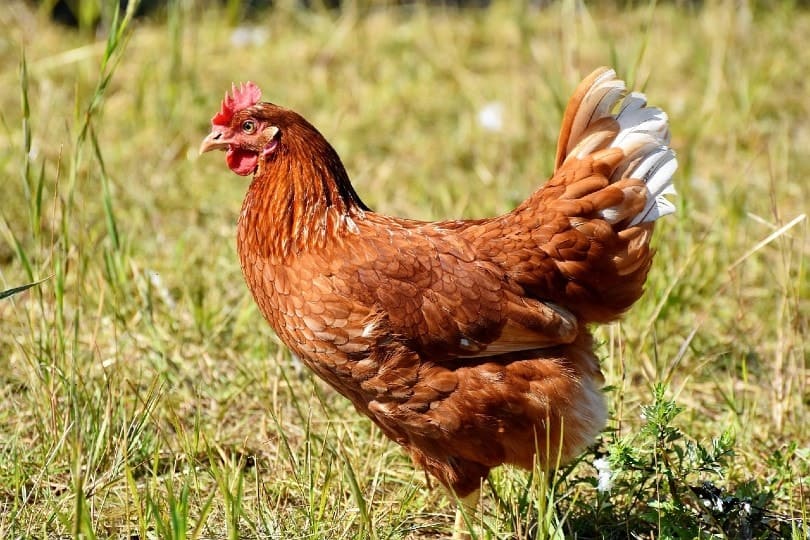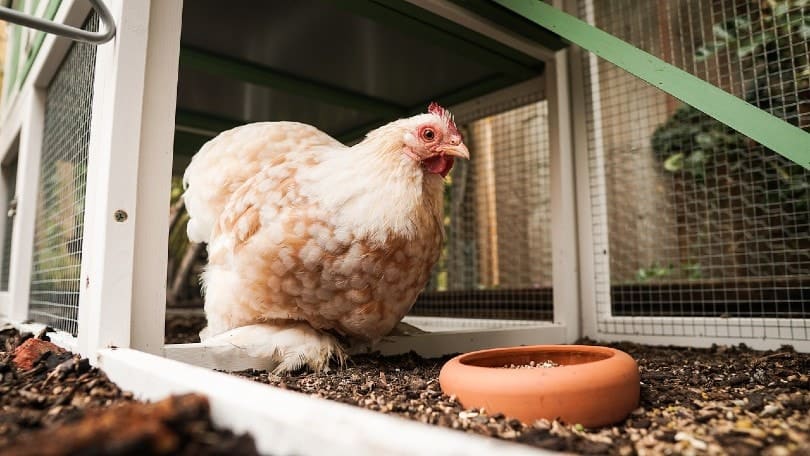Written by Dr. Luqman Javed
Chickens are hardy animals and can tolerate a wide range of temperatures. This includes temperatures below freezing and overly warm temperatures that would be considered too hot for mammals.
Understanding how chickens regulate their body temperature and control mechanisms that they make use of during undesirable temperatures is important and, in this article, we will provide you with all the answers you need when it comes to the temperature requirements for chickens.

Understanding How Chickens Control Their Body Temperature
The core body temperature of fully feathered adult chicken is around 40–42 °C (104–107.6 °F). The thermal neutral zone for chickens is 18–24 °C (64.4–75 °F). In this temperature range, chickens do not need to thermoregulate themselves.
How Do Chickens Regulate Body Temperature?

Chickens have five main factors which help them regulate their temperature if it ever falls above or below their ideal temperature range.
- Feathers
- Subcutaneous fat
- Blood flow control
- Flock behavior
- Ability to change their body surface area to dissipate heat
How Chickens Thermoregulate When It’s Too Warm
When chickens are warm, they thermoregulate by panting. Like all birds, chickens can regulate their blood vessels by widening or constricting their blood vessels. When chickens are warm, they are able to widen their blood vessels to increase the blood flow to their wattles and combs. This allows them to dissipate more heat.
In addition, chickens hold their wings away from their body when they are arm, this allows for more surface area on the body, allowing them to further dissipate heat away from their body.
Chickens are unable to sweat, and their ability to thermoregulate when warm is not as good as their ability to thermoregulate when they are feeding cold.
How Chickens Thermoregulate When It’s Too Cold
Chickens are better able to cope with the cold than heat. Their feathers are able to conserve heat and keep them warm. In addition, subcutaneous fat is a natural insulation for these birds.
When chickens feel cold, they constrict their blood flow to their extremities, helping them conserve heat. In addition, they will hold their wings close to their body to minimize the surface area of their body. Finally, flock members will huddle together when they feel cold.

What Temperature Is Too Cold for Chickens?
Chickens can withstand temperatures below freezing (approximately 32°F to 20°F). If the temperature drops any lower than this, your chicken’s body will start to slow down, their metabolism decreases, and they will become inactive.
Although chickens can tolerate very cold temperatures quite well, you should still ensure that their sleeping area is fully covered, insulated, and warm during the wintertime. It may also be a good idea to place a thermometer in their coop to monitor the drop in temperature during winter. Your chicken will not enjoy being exposed to harsh winter elements – such as snow, icy winds, hail, and heavy rain.
It is important to note that chicks cannot thermoregulate well and do not handle the cold well. They require additional heat to keep warm (either from a hen or an incubator) to ensure that they don’t get cold.

What Temperature Is Too Hot for Chickens?
Temperatures that exceed 29.4–32.2 °C (85–90 °F) increase your chicken’s risk of developing heat stress and dehydration. Overly warm environments can also make your chicken feel uncomfortable because they do not cool down the same way we do. Furthermore, prolonged hot temperatures and high humidity make for an uncomfortable combination. Heavier breeds of chickens are more susceptible to overheating.
Keep in mind that since chickens have a warmer core body temperature a few degrees warmer than humans, they will feel the heat more intensely. Since chickens cannot cool themselves down with the help of cold water or shade, you may notice that your chicken seems more lethargic and duller on hot days. Please note that chicks need warmth but shouldn’t be exposed to temperatures that are too high, as they will quickly overheat.

Signs Your Chicken Is Overheating
To determine if your chicken is overheating, you can place your hand between their legs and feel if they are giving off a lot of heat. They can also show physical and emotional signs in the form of:
- Panting heavily
- Holding wings away from body
- Listlessness
- Reduced appetite
- Hiding
- Fighting for shade or cool spots
- Early molting
- Reduced egg-laying
If you notice that your chicken is acting lethargic with their heads down, wings extended, and mouths open, then they may be suffering from a serious case of heatstroke and dehydration. It will then be necessary to get them to a cool, shaded spot and keep them in a shallow container of cool water during the day. Roaming chickens should have access to a covered coop to retreat to if they ever feel too warm.
The chicken’s water should always be kept cool during the summer months. Warm water further increases your chicken’s body temperature which does not help them overcome hot weather. Always ensure the water is kept in a shaded area and add ice packs to the dish every few hours if necessary.
Contact your avian veterinarian right away if you suspect that your flock is suffering from extreme signs of heat stress.
A Note About Chicks
As mentioned above, chicks are unable to thermoregulate their temperature as well as adults until their adult feathers come through. It is important to not allow them to become too warm or too cold, as they don’t handle either extremes as well as adults do.
Hens often help chicks thermoregulate by brooding them whenever they feel like their chicks might be too cold.
In the absence of a hen, you would have to use an incubator to keep your chicks warm. Their ideal temperature depends on their age.
Temperature on the floor, at the edge of the heat source, should be 32–35°C (90–95°F) for the first week of life. As long as the temperature at the edge of the heat lamp or brooder stove is this warm, the air temperature 2 meters (6 feet) away from the heat source can be as low as 28°C (82°F). The chicks can then choose where they feel most comfortable. If you cannot maintain a hot point next to the heat lamp, an average air temperature of 30–31°C (85–88°F) is suggested.
The temperature should be reduced by 3°C (5°F) per week, until the room temperature of 20ºC (70ºF) is reached. After 6 weeks of age, temperatures in the 18–24 °C (64.4–75 °F) range are desirable.

Conclusion
Since chickens can easily adapt to a wide range of temperature requirements, it is easy to see why they are such beloved pets and farm animals. They can be kept in many different states regardless of if the summer becomes hot or the winters become icy. Overall, it is best to ensure that your chicken is provided with the right accommodation, plenty of water, shade, and warm spots to keep them comfortable through each seasonal change.
Featured Image Credit: nikolaus-online, Pixabay
